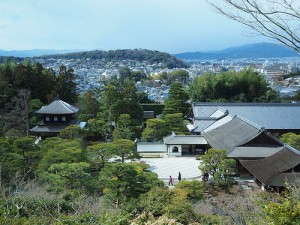- Home
- Architecture
- Ginkakuji | Contrary to its name it’s not plated in silver!
Ginkakuji | Contrary to its name it’s not plated in silver!

In Kyoto, there are various famous tourist attractions and the popular one among them is Kinkakuji, isn’t it? Well, do you know the temple named Ginkakuji as the opposition to Kinkakuji? The official name of Ginkakuji is Higashiyama Jishoji. It is a mountain villa built in Higashiyama, Kyoto in 1489 by Ashikaga Yoshimasa, who was the eighth shogun of Muromachi Shogunate, referring to Kinkakuji which was built by his grandfather Ashikaga Yishimitsu. Contrary to his grandfather who kept taking the reins of government in Kinkakuji, Ashikaga Yoshimasa broke with politics in Ginkakuji.
Kinkakuji looks literally gold (kin means gold in Japanese), but Ginkakuji looks not silver (gin means silver in Japanese) but nearly black as the picture shows. Then why is it called Ginkakuji? There are some reasons.
One reason is that silver leaf could not be put over it becasuse of lack of money in Muromachi Shogunate. Shogun lost his authority due to the war which lasted ten years and there was no one who supplied money to build Ginkakuji. Moreover, it is also said that silver leaf was too expensive to get at that time and could not applied to the roof though they intended to do before. However, it is also said that there was not such a plan basically.
Another reason is that Rokuonji became to be called Kinkakuji in the Edo period and then Jishoji, which was also the mountain villa, was named Ginkakuji. This one is assumed to be the accurate origin of the name.

There is a hall called Togudo in Ginkakuji. Inside this hall was built in the way called shoin zukuri which is the origin of modern Japanese rooms. Shoin zukuri is the architecture for samurai houses and it contains traditional Japanese tatami, fusuma, chigaidana, etc. From this building which was used as chashitsu (tea ceremony room) or shosai (a study), Japanese culture like Sadou (the tea ceremony), Kadou (the art of flower arrangement), Noh (one of Japanese classic theater forms), and so on were said to be born.

We feel WabiSabi (quiet simplicity and subdued refinement) deeply from Ginkakuji. When you visit Kyoto, we recommend you to go there as well as Kinkakuji!
Photo by JAKUTAKU, Kentaro Ohno, Junya Ogura











